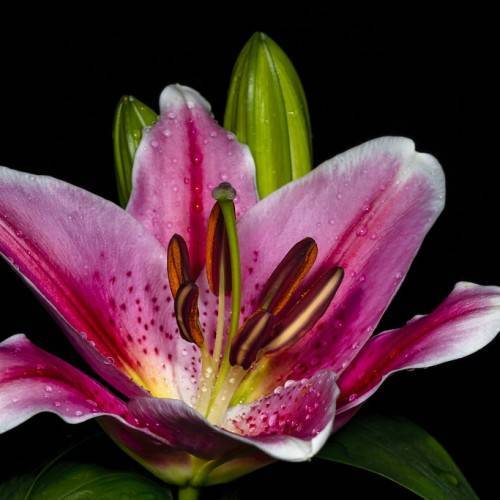
oriental lily
Lilium 'Miss Rio'
Cycle:
Perennial
Watering:
Average
Hardiness Zone:
5 - 8
Flowers:
Flowers
Sun:
Full sun,part shade
Leaf:
Yes
Growth Rate:
High
Maintenance:
Low
Care Level:
Medium
watering
Oriental lilies (Lilium 'Miss Rio') should be watered often, but lightly. It is best to water the plant at least once per week, and ensure that the soil is consistently moist, but not soggy or waterlogged. When watering, avoid getting the leaves wet, as this can lead to fungal diseases. Water in the morning or early afternoon so the plant has time to dry off before temperatures drop at night. If grown in a pot, check for adequate drainage and use a pot with a good drainage hole. In summer, water more frequently, as temperatures are usually higher and the soil will dry out faster. If grown in the garden, water deeply and slowly by setting out a hose.
sunlight
Oriental lilies prefer full sun or partial sun for at least 6 to 8 hours a day to thrive. It is best to provide this sunlight in the morning hours from 6-10 am, as this is when the plant will need the most sun. Also, allowing the lily to receive late-afternoon shade is beneficial, as this will help the plant to stay cool in hot afternoons. Oriental lilies do not require direct sunlight throughout the day and should be protected from the intense mid-afternoon sun. Generally, the ideal amount of sunlight for the Oriental Lily would be about 6-8 hours per day, with the majority of sun exposure occurring at the beginning of the day.
pruning
Oriental lilies require regular pruning to keep them looking their best and promote new growth. Prune your Oriental lilies in early summer. Start by removing all dead or damaged flower stems. Next, trim back about 1-third of the height of the lily stem. Be careful not to cut off any of the healthy, green leaves. Finally, cut off any flowers that are still in bloom to prevent the lily from using its energy to form seed pods. This will help ensure that the lily will continue to produce beautiful blooms.
